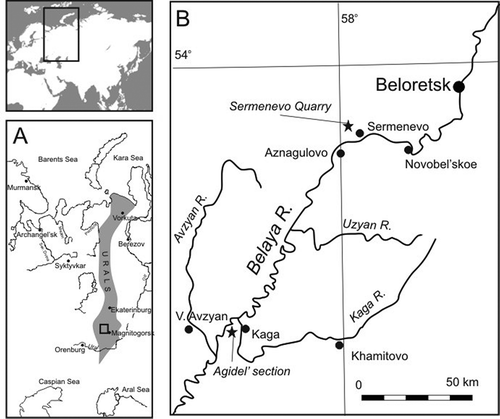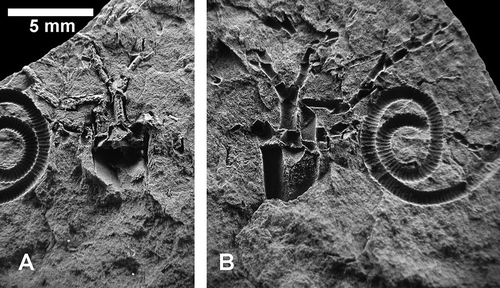ABSTRACT
Crinoids and brachiopods are described from the Silurian Uzyan Formation of the Zilair Zone in the southern Urals. The occurrence of the graptolites Coronograptus praedeubeli suggests a late Homerian (Wenlock) age for the strata. A new disparid crinoid, Cicerocrinus gracilis Donovan sp. nov., is the oldest known member of this genus. It has a long, flexible and homeomorphic column, and a tall bryozoan palaeontology terminology (IBr2) (second primibrachial) axillary. All species of Cicerocrinus described previously have been limited to the Ludlow of the British Isles, Sweden and Estonia, and the Pridoli of Estonia. The poorly preserved brachiopod fauna is represented by small atrypid (Atrypa? sp.) and dalmanellid brachiopods (Levenea? sp.). The reported assemblage generally inhabited deep-water environments.
Introduction
When Roderick Impey Murchison (1792–1871) travelled to Russia for the first time in 1840, it was not with any anticipation of what would be the most significant contribution of this tour. That is, it was his definition of the Permian System that was of truly international importance (Holliday Citationin press). Rather, he was initially intent on determining the wider extent of the Silurian and Devonian systems, major stratigraphic entities defined by Murchison and by Adam Sedgwick (1785–1873) and Murchison, respectively. Murchison was rightly called the “King of Siluria” (Morton Citation2004) and, in Russia, he successfully extended his “empire” far to the east.
The present paper describes new discoveries of crinoids and brachiopods from the Russian part of the Silurian “empire”, in the succession of the southern Urals (). Crinoids and brachiopods are relatively well known from the Silurian of the southern Urals; however, there are just a few publications (e.g., Tyazheva & Zshavoronkova Citation1972; Militsyna Citation1980) dealing with their systematic palaeontology. Crinoids, reported from a few Silurian localities, are based mainly on disarticulated elements of the stem and include the following taxa: Bystrowicrinus (col.) Yeltysheva, Crotalocrinites Austin & Austin, Egiasarovicrinus (col.) Schewtschenko, Syndetocrinus Kirk and Turuchanocrinus (col.) Stukalina (Militsyna Citation1980; Stukalina Citation2000). Note that Webster & Webster (Citation2014, p. 2671) considered Turuchanocrinus (col.) to be a nomen nudum. Brachiopods are mainly represented by pentamerids (Conchidium, Pentamerus and Subriana) (Ozhiganov Citation1955; Krauze & Maslov Citation1961). Neither of these fossil groups has previously been reported from the Zilair Zone.
Geological setting and stratigraphy
Silurian sedimentary successions are well known in the southern Urals from both exposures and wells. They were described by Ozhiganov (Citation1955), Klochikhin (Citation1960), Krauze & Maslov (Citation1961), Yakupov et al. (Citation2002) and Artyushkova et al. (Citation2011). The Zilair Zone forms a SW plunging, broad synform of Ordovician to Devonian siliciclastic and carbonate sedimentary rocks (Bastida et al. Citation1997), which unconformably overlie Neoproterozoic basement. The platform sedimentary rocks are overlain by Upper Devonian flysch, which forms the entire core of the synclinorium (Puchkov Citation1997). The southern Urals sector of the Zilair Zone is interpreted to represent a continental slope and rise basin setting (Brown et al. Citation1998). The sequences of the three sections examined in this zone comprise three successive formations, Yuzhno, Uzyan and Sermenevo formations (). The lowermost Yuzhno Bainazarovo Formation is characterised by claystones, siltstones and thin beds of limestones. Mudstones and shales make up the ~500-m-thick Uzyan Formation (Maslov et al. Citation2008). The overlying Sermenevo Formation is represented by dark grey massive dolostones and black bituminous limestones. Only the Uzyan Formation is discussed further below. Based on its included graptolites and conodonts, the Uzyan Formation is considered to be of late Llandovery to Wenlock age (Yakupov et al. Citation2002).
Figure 2. Stratigraphic chart for the Zilair Zone of the southern Urals (from Yakupov et al. Citation2002).
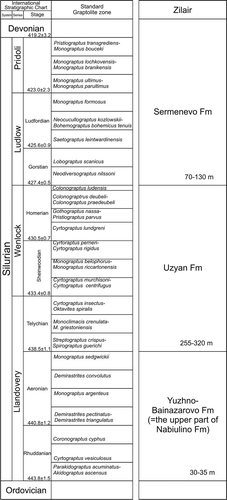
Materials
The studied palaeontological specimens were collected at two localities (): the Sermenevo Quarry, and the Agidel’ section. At Agidel’, in the valley of the Belaya River, 5 km NW of the village of Kaga, the dark grey to grey, well-laminated shales and interbeds of siltstones, make up an ~160 m of the Uzyan Formation (, ). Shales at about ~145 m from the base of the section yield rare Homerian graptolites Colonograptus cf. ludensis . In contrast to the shales, siltstones contain crinoid columnals and small atrypid brachiopods (, ). To date these are the first fossil discoveries in this section.
Figure 3. Stratigraphy, correlation and fauna of the Agidel’ and Sermenevo sections referred to in the text. The black dots show the location of samples.
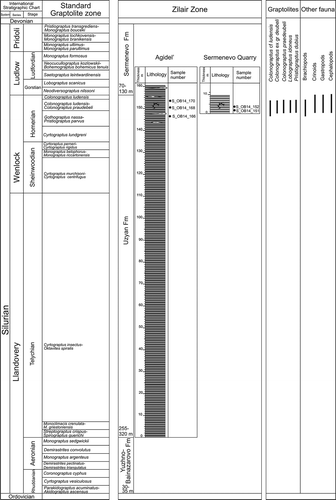
Figure 4. Dark-coloured shale unit of the Uzyan Formation, showing slaty cleavage, Agidel’ section, Belaya River.
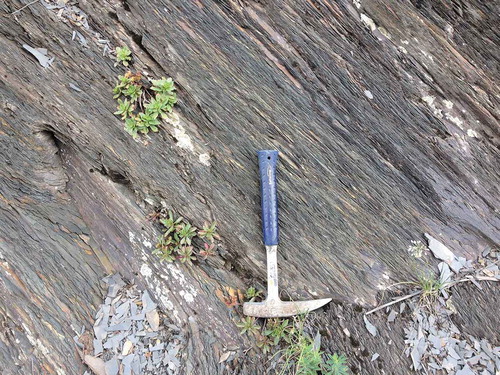
Figure 5. Dark grey mudstones, Uzyan Formation, Sermenevo Quarry, near the village of Sermenevo. Hammer for scale.
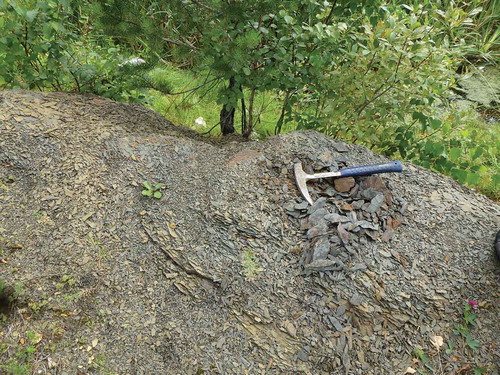
Figure 6. Brachiopods from the Uzyan Formation of the southern Urals. A Dalmanellid Levenea? sp. B and C Atrypid Atrypa? sp. All scale bars represent 10 mm.
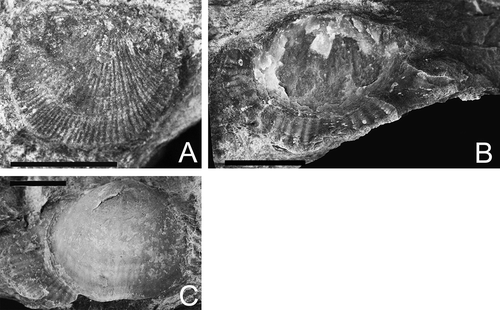
At the Sermenevo Quarry, located 3 km NW of the village of Sermenevo (), a ~ 10-m-thick succession of unmetamorphosed dark grey to green and brownish carbonaceous-silty mudstones (shales) is exposed (, ). Rocks yield poorly preserved graptolites, brachiopods (), crinoids (, ), orthoceratid cephalopods, gastropods and bryozoans. The graptolites Colonograptus ex gr deubeli, C. praedeubeli, Lobograptus idoneus (Koren’ et al. Citation1996) and Pristiograptus dubius have been identified, indicating the C. deubeli – C. praedeubeli Biozone (Koren’ et al. Citation1996) of the upper Homerian stage of the Wenlock Series. It should be noted that Paalits et al. (Citation1998), while examining the same quarry, mistakenly referred to this interval as the Sermenevo Formation. Subsequently, Yakupov et al. (Citation2002) placed the Paalits et al. (Citation1998) data, obtained from this interval within the upper part of the Uzyan Formation.
Figure 7. Cicerocrinus gracilis Donovan sp. nov. All paratypes unless stated otherwise. A PMU 28 748, long, partly disarticulated pluricolumnal. B F PMU 28746a and PMU 28746b, respectively, part and counterpart, curved and coiled pluricolumnals. C PMU 28745a, cup (holotype) angled to lower left next to a paratype, planar coiled pluricolumnal. D PMU 28 752, long, sinuously curved pluricolumnal. E G PMU 28 749, coiled pluricolumnal. H PMU 28 750, disarticulated columnals. I PMU 28 751, long curved pluricolumnals. A-D, G, H These are latex casts; other specimens are natural moulds. All specimens coated with ammonium chloride. All scale bars represent 10 mm.
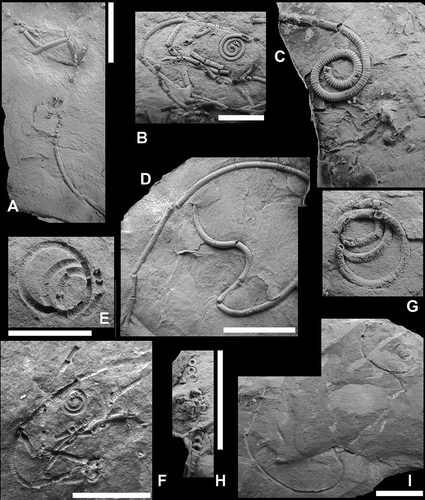
Remarks on brachiopods
No taxonomic description is given for the herein reported brachiopods due to the poor preservation of specimens. Brachiopods, collected in both the Agidel’ section and the Sermenevo Quarry (Sites 1 and 2), are represented by just three, variably exfoliated valves prepared from the hard, slate matrix together with a number of shell fragments. The fauna is characterised by a relatively small atrypid brachiopod (, ). Two near-complete dorsal valves are convex with a slight fold, coarse ribs and a well-developed anterior frill; there is a marked sublamellose concentric sculpture and several spine bases are preserved. The general morphology and ornament is similar to Atrypa sensu stricto, which ranges from the Llandovery to Lower Devonian. It is referred to Atrypa? sp. herein.
The small dalmanellid brachiopod () is similarly poorly preserved, but the dorsal valve is nearly complete. The valve is small, moderately convex, with a weak dorsal sulcus. The ornament is costellate; ribs arise by simple bifurcation, with a moderately strong concentric sculpture. The shape, dorsal sulcus and simple branching of relatively fine costae and costellae is similar to those of Levenea, an isorthin ranging from the Llandovery to Middle Devonian, generally inhabiting deeper-water environments. This specimen is referred to Levenea? sp.
Systematic palaeontology
Remarks
The specimens described herein are deposited at the Museum of Evolution, Uppsala University, Uppsala, Sweden (prefix PMU). Terminology of the crinoid stem follows Moore et al. (Citation1968), Moore (Citation1978a)) and Ubaghs (Citation1978). The structure of the systematic description follows Fearnhead (Citation2008).
Class Crinoidea Miller Citation1821Subclass Disparida Moore & Laudon Citation1943Order Pisocrinida Ausich & Copper Citation2010Family Pisocrinidae Angelin Citation1878Genus Cicerocrinus Sollas Citation1900 1900 Lagarocrinus Jaekel, pp. 480–481.
Type species
Cicerocrinus elegans Sollas, Citation1900, by monotypy (Moore et al. Citation1978b, p. T536); probably from the Upper Ludlow of the British Isles, precise locality unknown (Ramsbottom Citation1958, p. 111).
Other nominal species
In addition to the type species, Webster (Citation2003) and Webster and Webster (Citation2014) recognised the following additional species of Cicerocrinus: Cicerocrinus anglicus (Jaekel Citation1900) (Silurian, Ludlow, Wales); C. osiliensis (Jaekel Citation1900) (Late Silurian, Estonia); C. scanicus (Jaekel Citation1900) (Late Silurian, Sweden and Estonia).
Diagnosis
(Revised after Moore et al. Citation1978b, p. T536.) Cup high and conical, with upright elongate basals. Basals 5, unequal in size; AE and BC smaller than other three basals and with truncated, rather than acute, distal edge. Radials also unequal in size; C and E radials small, triangular and not in contact with basals; B ray with small triangular superradial and large inferradial which is shifted obliquely to the left and situated directly above the BC basal; D and A radials are large, simple, in contact with basals, and together with the B inferradial comprise most of the theca (see Sollas Citation1900; ; reproduced in Donovan et al. Citation2009; text-fig. 10, with explanatory caption). Anal X small, on upper right shoulder of D radial. Arms branch on second primibrachial in all rays, each arm with two main rami or with an additional division high above the cup. Secundibrachials bear stout unbranched ramules on alternate sides of every second brachial.
Remarks
The oldest pisocrinid known, Eocicerocrinus sevastopuloi Donovan, Citation1989, from the Ashgill (Katian; Upper Ordovician) of the Laurentian of south-west Scotland (see also Donovan & Clark Citation2015), is the only other pisocrinid genus with branched arms. All other pisocrinids – Calycanthocrinus Follman, Parapisocrinus Mu, Pisocrinus de Koninck and Triacrinus Münster – have unbranched arms; the arms are unknown in Jaekelicrinus Yakovlev (Moore et al. Citation1978b; pp. T533-T537; Donovan Citation1989; p. 69).
Range
Silurian, Wenlock, southern Urals (herein); Ludlow, northern Europe, British Isles, Sweden, Estonia (Webster Citation2003); Pridoli, Estonia (Ausich et al. Citation2012, Citation2015).
Cicerocrinus gracilis Donovan sp. nov.,
Etymology
Latin gracilis, meaning “slender”, in reference to the long and slender column of this species.
Type material
Holotype, PMU 28754a, PMU 28747a and PMU 28745b, PMU 28746a (, ), part and counterpart (PMU 28746b is also a counterpart to PMU 28746a, but this surface bears paratypes only). Other paratypes, PMU 28 748, PMU 28 749, PMU 28 750, PMU 28 751, PMU 28 752, PMU 28 753, PMU 28754a, PMU 28754b (part and counterpart), PMU 28 755 and PMU 28 756 ().
Type locality
Sermenevo Quarry, 3 km NW of the village of Sermenevo, Beloretsk Region, Bashkortostan, Russia.
Diagnosis
A species of Cicerocrinus with a particularly long, flexible, homeomorphic column and a tall IBr2 axillary brachial.
Description
Attachment structure unknown. Column circular to rounded pentagonal in section, long, gracile and flexible (). Articulation symplectial, marginal, comprised of short, unbranched crenulae; circular areola; lumen central, moderately broad, circular(?) (). Column homeomorphic (or, possibly, weakly heteromorphic; differences in height of columnals are subtle). Columnals with convex, unsculptured latera. Cup incomplete and crushed, basals not seen, but apparently tall and gently conical or cylindrical, unsculptured. On specimen PMU 28747b (), E radial small, triangular, resting on shoulders of adjacent, larger, polygonal D and A radials; plating on specimen PMU 28747a less easily decipherable (). Arms partly disarticulated, incomplete, unsculptured, uniserial, apinnulate, branching isotomously at IBr2. IBr1 low, trapezoidal, broadest at base. IBr2 over twice the height of IBr1, axillary, aboral latera gently concave. Secundibrachials more slender, cylindrical in aboral view, higher than wide, first ramules supported by IIBr2-3. Ramules more slender than secundibrachs. Brachials U-shaped in section; adoral groove V-shaped in section.
Remarks
Cicerocrinus gracilis sp. nov. is the oldest known member of this genus. All species described previously have been limited to the Ludlow and Pridoli. Cicerocrinus gracilis is easily distinguished from the type species, C. elegans Sollas, and C. osiliensis (Jaekel), both of which bear low, broad, axillary IBr2 (compare with Sollas Citation1900, ; Jaekel Citation1900, ; respectively). The holotype and only specimen of Cicerocrinus anglicus is lost and was never figured, and Jaekel’s description (Citation1900; pp. 486–487; Donovan et al. Citation2009; p. 31) is inadequate for comparison. Cicerocrinus scanicus (Jaekel) differs from C. gracilis in its robust arrangement of ramules (compare Jaekel Citation1900; with herein).
The long and contorted column of C. gracilis is noteworthy. The slender, coiled pluricolumnals almost certainly collapsed after death rather than form a distal planar coiled attachment (Baumiller & Ausich Citation1996). The long pluricolumnals indicate that C. gracilis was adapted to maintain the crown high above the sediment surface to harvest food from water that was free of sediment.
Summary
A new collection of crinoids and brachiopods from the Silurian of southern Urals are reported and described herein. Taxa from the upper part of the Uzyan Formation (Wenlock) are represented by atrypid (Atrypa? sp.) and dalmanellid brachiopods (Levenea? sp.), and the pisocrinid crinoid Cicerocrinus. The latter material is significant recording a new disparid crinoid, Cicerocrinus gracilis Donovan sp. nov., which is the oldest known member of this genus, previously limited to the Ludlow of Sweden, Estonia and the British Isles, and the Pridoli of Estonia.
Acknowledgements
Fieldwork in the Urals 2015 was funded by the consortium of oil and gas industry subscribers for the Silurian Shale Project in CASP (University of Cambridge, UK). David Harper acknowledges support from the Leverhulme Trust (UK). We thank two anonymous reviewers for their comments.
Disclosure statement
No potential conflict of interest was reported by the authors.
References
- Angelin, N.P., 1878: Iconographia crinoideorum in Stratis Sueciae Siluricus fossilium. Holmiae, iv+62 pp.
- Artyushkova, O.V., Suyarkova, A.A., Mavrinskaya, T.M. & Yakupov, R.R., 2011: On the age of the black shale Varna Formation in its stratotype area. In Geological collection of papers, 9, 27—31. Institute of Geology, Ufa. [In Russian.]
- Ausich, W.I. & Copper, P., 2010: The crinoidea of Anticosti Island, Québec (Late Ordovician to early Silurian). Palaeontographica Canadiana 29, 1—157.
- Ausich, W.I., Wilson, M.A. & Vinn, O., 2012: Crinoids from the Silurian of western Estonia. Acta Palaeontologica Polonica 57, 613–631. doi:10.4202/app.2010.0094.
- Ausich, W.I., Wilson, M.A. & Vinn, O., 2015: Wenlock and Pridoli (Silurian) crinoids from Saaremaa, western Estonia (Phylum Echinodermata). Journal of Paleontology 89, 72–81. doi:10.1017/jpa.2014.6.
- Bastida, F., Aller, J., Puchkov, V.N., Juhlin, C. & Oslianski, A., 1997: A cross section through the Zilair Nappe (southern Urals). Tectonophysics 276, 253—263. doi:10.1016/S0040-1951(97)00059-0.
- Baumiller, T.K. & Ausich, W.I., 1996: Crinoid stalk flexibility: theoretical predictions and fossil stalk postures. Lethaia 29, 47—59. doi:10.1111/j.1502-3931.1996.tb01836.x.
- Brown, D., Juhlin, C., Alvarez-Marron, J., Perez-Estaun, A. & Oslianski, A., 1998: Crustal-scale structure and evolution of an arc-continent collision zone in the southern Urals, Russia. Tectonics 17, 158—171. doi:10.1029/98TC00129.
- Donovan, S.K., 1989: Pelmatozoan columnals from the Ordovician of the British Isles. Part 2. Monographs of the Palaeontographical Society, London 142 (580), 69–114.
- Donovan, S.K. & Clark, N.D.L., 2015: A collection of pelmatozoans (Echinodermata) from the lady burn starfish beds (Upper Ordovician, Katian), SW Scotland. Scottish Journal of Geology 51, 125—130. doi:10.1144/sjg2015-001.
- Donovan, S.K., Lewis, D.N., Fearnhead, F.E. & Widdison, R.E., 2009: The British Silurian Crinoidea. Part 1, introduction and disparida. Monographs of the Palaeontographical Society, London 163 (632), 1—45.
- Fearnhead, F.E. 2008: Towards a systematic standard approach to describing fossil crinoids, illustrated by the re-description of a Scottish Silurian Pisocrinus de Koninck. Scripta Geologica 136, 39—61.
- Holliday, D.W. in press: Adam Sedgwick, Roderick Murchison, the Magnesian Limestone (Zechstein) of northeastern England and the foundation of the Permian system. Proceedings of the Yorkshire Geological Society 62, 6. doi:10.1144/pygs2017-006.
- Jaekel, O., 1900: Ueber einen neuen Pentacrinoideen-Typus aus dem Obersilur. Zeitschrift der Deutschen geologischen Gesellschaft 52, 480—487.
- Klochikhin, A.V., 1960: The Ordovician, Silurian and lower Devonian of the eastern limb of the Zilair Synclynorium on the southern Urals. In Some questions on the geology of the eastern margin of the Russian platform and the Southern Urals Vol. 7, 33—36. Institute of Geology, Ufa. [In Russian.]
- Koren’, T.N., Lenz, A., Loydell, D.K., Melchin, M., Storch, P. & Teller, L., 1996: Generalized graptolite zonal sequence defining Silurian time intervals for global paleogeographic studies. Lethaia 29, 59–60. doi:10.1111/j.1502-3931.1996.tb01837.x.
- Krauze, S.N. & Maslov, V.A., 1961: The Ordovician, silurian and lower devonian of the western slope of the West Bashkirian Urals. 94 (Ufa: Institute of Geology, Ufa. 94 pp. [In Russian.]
- Maslov, V.A., Artyuchkova, O.V., Yakupov, R.R. & Mavrinskaya, T.M., 2008: Some problems in early and middle palaeozoic stratigraphy of the southern Urals. In Geological Collection of Papers 7, 193—204. Institute of Geology, Ufa. [In Russian.]
- Militsyna, V.S., 1980: The Ordovician and Silurian Cystoidea and Crinoidea from the Urals. Palaeontological Society of the USSR, Leningrad 23, 198—212. [In Russian].
- Miller, J.S., 1821: A natural history of the Crinoidea or lily-shaped animals, with observations on the genera Asteria, Eurayle, Comatula and Marsupites. C. Frost, Bristol. 150 pp.
- Moore R.C. with additions by Ubaghs, G., Rasmussen, H.W., Breimer, A. & Lane, N.G., 1978a. R.C. Moore & C. Teichert (eds.): Treatise on invertebrate paleontology, Part T, Echinodermata 2, 2, T229, T231, T233–242. Geological Society of America and University of Kansas, Boulder and Lawrence.
- Moore, R.C., Jeffords, R.M. & Miller, T.H., 1968: Morphological features of crinoid columns. University of Kansas Paleontological Contributions, Echinodermata Article 8, 1—30.
- Moore, R.C., Lane, N.G., Strimple, H.L. & Sprinkle, J., 1978b: Order disparida Moore & Laudon, 1943. In: R.C. Moore & C. Teichert (eds.): Treatise on Invertebrate Paleontology, Part T, Echinodermata 2, 2, T520—T564. Geological Society of America and University of Kansas, Boulder and Lawrence.
- Moore, R.C. & Laudon, L.R., 1943: Evolution and classification of paleozoic crinoids. Geological Society of America Special Paper 46, 1—153.
- Morton, J.L., 2004: King of Siluria: how Roderick Murchison changed the face of geology. Brocken Spectre Publishing, Horsham. 276 pp.
- Ozhiganov, D.G., 1955: Stratigraphy and facies features of the Silurian of the western slope of the southern Urals. Scientific Notes of the Baskhirian Pedagogical University 4, 55—92. [In Russian.]
- Paalits, I., Maletz, J., Maslov, A. & Erdtmann, B.-D., 1998: Age and fossils of the Sermenevo formation (Silurian), southern Urals (Russia). Newsletters on Stratigraphy 36, 145—156. doi:10.1127/nos/36/1998/145.
- Puchkov, V.N., 1997: Structure and geodynamics of the Uralian Orogen. In: J.-P. Burg & M. Ford (eds.): Orogeny through time Special Publication 121, 201—236. Geological Society, London.
- Ramsbottom, W.H.C., 1958: British Upper Silurian crinoids from the Ludlovian. Palaeontology 1, 106—115.
- Sollas, W.J., 1900: On two new genera and species of Crinoidea. Quarterly Journal of the Geological Society, London 56, 264—272.
- Stukalina, G.A., 2000: Paleozoic Crinoids. Practical MANUAL on Macrofauna. VSEGEI Press, St Petersburg. 283 pp. [In Russian.]
- Tyazheva, A.P. & Zshavoronkova, R.A., 1972: The corals and brachiopods from Silurian - Lower Devonian marginal deposits on the west slope in the South Urals. Nauka, Moscow. 184 pp.. [In Russian]
- Ubaghs, G., 1978: Skeletal morphology of fossil crinoids. In: R.C. Moore & C. Teichert (eds.): Treatise on Invertebrate Paleontology, Part T, Echinodermata 2, 1, T58—T216. Geological Society of America and University of Kansas, Boulder and Lawrence.
- Webster, G.D., 2003: Bibliography and index of Paleozoic crinoids, coronates, and hemistreptocrinoids. Geological Society of America Special Paper 363, 1758–1999. http://crinoid.gsajournals.org/crinoidmod. [Currently offline.]
- Webster, G.D. & Webster, D.W., 2014: Bibliography and index of Palaeozoic Crinoids: paleozoic crinoids, coronates, and hemistreptocrinoids, 1758–2012. viii+2694 pp. http://crinoids.azurewebsites.net/ (Accessed 16th May, 2018).
- Yakupov, R.R., Mavrinskaya, T.M. & Abramova, A.N., 2002: A palaeontological validation of the Palaeozoic stratigraphic chart of the northern part of the Zilair Megasynclinorium. Institute of Geology, Ufa. 160 pp. [In Russian.]

